The Palais-de-Justice-de-la-Cité is located in the heart of Paris on the Île de la Cité of Paris, near the Sainte Chapelle, the Conciergerie and the Tour de l'Horloge. The Palais occupies more than 4 hectares (10 acres) on the ground and develops on the floors nearly 200,000 m². Inside, there are approximately 24 kilometers of corridors, 7,000 doors, and more than 3,150 windows.
The history of the Palais-de-Justice-de-la-Cité is often that of the city of Paris.
It is also inseparable from the history of royalty since the Palais-de-Justice-de-la-Cité was for a long time the residence of the rulers. Monarch by divine right, the king concentrates in his person the legislative power, the executive power... but also the judicial authority. The history of the Palace up to the 10th century is almost completely unknown to us. This is easily explained if we observe that the Merovingian and Carolingian kings and their courts did not have a fixed residence. They may have sometimes resided on the Île de la Cité.
The Courthouse and fires
Over the centuries, the Palais-de-Justice-de-la-Cité has undergone innumerable fires and reconstructions:
- In 1601, the Hall of Lost Steps was hit and the collection of wooden statues of the kings of France was destroyed.
- In 1618, the Grand'Salle was ravaged and its reconstruction was entrusted to Salomon de Brosse.
- In 1630, the spire of the Sainte Chapelle fell victim to fire.
- Then the "Cour des Comptes" suffered the same fate in 1737.
- In 1776, during the reign of Louis XVI, a fire consumed the area between the Conciergerie and the Sainte Chapelle. The facade that dominates the Cour du Mai, of the whole main entrance of the Palace, was rebuilt between 1783 and 1786 in neo-classical style with a colonnade. The monumental gate in wrought iron, very worked with gildings, which opens on the Cour du Mai, was executed in 1776 by the master locksmith Bigonnet.
- As the number of court cases continued to increase, the July Monarchy (1830-1848) launched a vast program to enlarge the Palace. These works will be completed under Napoleon III (1851-1870). The building site was almost completed when the events of 1870 broke out. (Abdication of Napoleon III and uprising of "La Commune"). The fire of May 24, 1871, which was set in various parts of the Palais de Justice by the dying Commune, destroyed almost a quarter of a century's work.
- The plans were redone and the work began again in 1883. The Conciergerie was nevertheless completed by this date.
- Since 1914, the Palace has not seen any work of this scale.
The Tribunals of the Palais de Justice and the relocation of the High Court (TGI)
The Palais-de-Justice-de-la-Cité housed alle the Courts of the town of Paris. Now It only houses the highest national court of justice (Cour de Cassation), the Court of Appeal of the regional jurisdiction (Paris), and the Special Assise Court (sensitive cases).
The Tribunal de Grande Instance (TGI, called Tribunal Judiciaire (TJ) since January 1, 2020) has been relocated since 2018 to the 17th arrondissement (North-West of Paris).
In September 2021, the Palais de Justice will host the trial of the attacks of November 13, 2015, for a period of six months, in a temporary building in the Salle des Pas Perdus. The trial of the attacks of January 2015 took place in 2020 at the new Palais de Justice.
Note: The Regional Directorate of the Judicial Police of the Paris Police Prefecture is leaving 36, Quai des Orfèvres (right next to the Palais de Justice de la Cité) for 36, rue du Bastion, in the 17th arrondissement, thus remaining close to the new court's headquarters.
The History that took place within the walls of the Palais-de-Justice-de-la-Cité
Within its walls, personal dramas were played out, to the rhythm of the trials that followed one another. But perhaps the most infamous was that of Queen Marie-Antoinette, during the Terror of the Revolution, when so many citizens were guillotined, after having been "judged" within the walls of the Palace of Justice (2270 were incarcerated in the nearby Conciergerie prison) by the Revolutionary Court between April 6, 1793, and May 31, 1795. The condemned left the Cour du Mai (the Court of May - in front of the main entrance) in carts of 12, in general, to be taken to the present Place de la Concorde, where the guillotine was located.
Marie-Antoinette's trial began on October 14, 1793, she was sentenced to the guillotine on October 16 at around 4:00 am, she died on the scaffold that same day at 12:1/4 pm. (The cell where Marie-Antoinette was imprisoned can be seen at the Conciergerie, entrance at 2 Quai de l'Horloge).
You can also visit the great hall of the "pas perdus" of the Palais de Justice, once a huge royal reception hall. Towards the western part of the palace are the Courts of Appeal, including the first Chamber of Appeal known to have hosted famous trials.
Some of the chambers and courts in which the trials were held are also worth seeing, such as the First Civil Chamber of the Tribunal de Grande Instance, where the Revolutionary Court sat, and where Queen Marie-Antoine was convicted.
You may take a break sitting in rooms of the former Tribunal de Grande Instance, provided that you are silent and if there are hearings or conferences taking place there on the day of your visit. The room of the Court of Cassation can be visited individually (a group is not allowed). There are 24 km of galleries and corridors in the Palace of Justice, but not everything can be visited.
The Palais-de-Justice-de-la-Cité: the current buildings
The present buildings are those that escaped the fire of 1870 by the Communards and those burnt down rebuilt after 1883.
- The facade that dominates the Cour du Mai, over the entire main entrance of the Palace, was rebuilt between 1783 and 1786 in neo-classical style with a colonnade. The monumental gate in wrought iron, very worked with gilding, which opens on the Cour du Mai, was executed in 1776 by the master locksmith Bigonnet. The statues of Charlemagne and Philippe Auguste are the work in 1860 of the sculptor Philippe Joseph Henri Lemaire.
- On the other side of the building, rue Harlay, between the columns, six large standing figures symbolize, from left to right, Prudence and Truth, Punishment and Protection, then Strength and Equity. The grand staircase is flanked by two majestic lying links.
- The east side façade, Quai de l'Horloge, is an extension of the Conciergerie façade.
- Finally, the West façade belongs mainly to the former Regional Directorate of the Criminal Investigation Department of the Paris Police Prefecture, 36, Quai des Orfèvres.

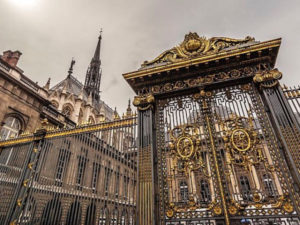
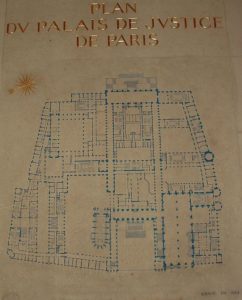
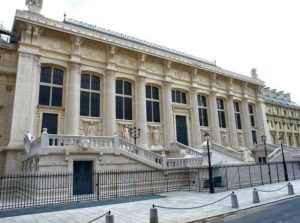
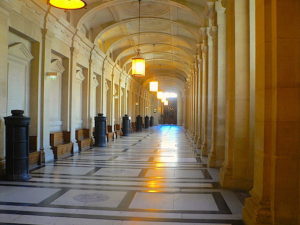
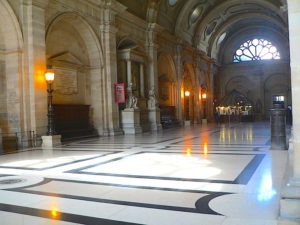
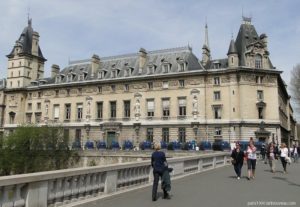
Add a review